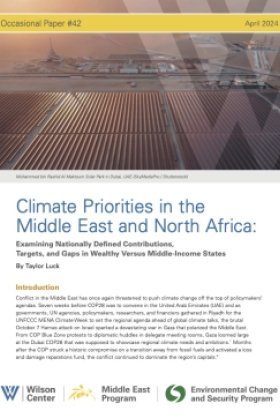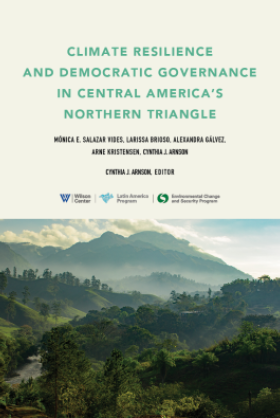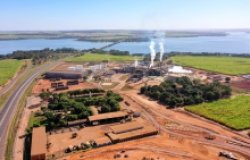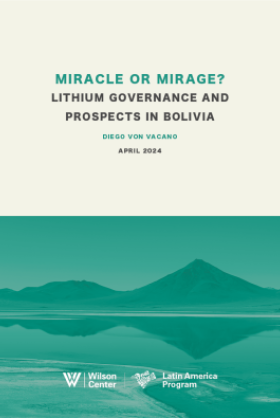China's Green Olympics: A Lasting Impact?
Since winning the Olympic bid in 2001, Beijing has invested heavily in green construction materials and sustainable energy for the Olympic Village, and made momentous efforts to clean the city's notoriously dirty air and water.
Overview
When Beijing made its bid for the 2008 Olympics, its air quality was vying with Mexico City as the most polluted capital in the world. Beijing ultimately won the bid over Toronto and Paris due to the extensive plans to make the 2008 Olympic Games green. At a September 26 meeting cosponsored by the Asia Program and the China Environment Forum, Jennifer Turner (Wilson Center) noted that since winning the bid in 2001, Beijing has invested heavily in green construction materials and sustainable energy for the Olympic Village and made momentous efforts to clean the city's notoriously dirty air and water. Beijing has also shut down or retrofitted 200 dirty industries in the city and made plans to keep 1.3 million cars off the roads for the entire two weeks of the Games. While Beijing residents today are experiencing many more days of blue skies, it is unclear whether all the efforts have been enough to guarantee clean air for the Games, for pollution from coal and cars in the region could nullify much of the progress.
While only a handful of international and domestic environmental nongovernmental organizations (NGOs) have been carrying out projects linked to the Olympics, the business community and multilateral agencies and bilateral aid organizations have been very active in piloting environmentally clean technologies in Beijing—particularly in the transportation and water sectors. In pondering the longer-term positive impact of the "green" Games, Jeff Fulgham (GE Water and Process Technologies) highlighted how the Beijing government has invested in expensive energy-efficient heating and transportation equipment and water-saving technologies that will greatly improve environmental quality beyond 2008. Peter Knights described another kind of lasting environmental impact his organization WildAid has been promoting—namely flashy public service announcements that use Olympic athletes with messages discouraging the consumption of endangered animals.
On Your Mark, Get Set…
This meeting began with a gunshot and a video clip of Olympic athlete Maurice Greene outrunning a speeding bullet to save a tiger. After grabbing the bullet midair Greene turns to the camera and sternly states: "You don't have to be the world's fastest man to beat a speeding bullet. We can save our endangered animals. When we all come together, we can do anything." This public service announcement produced by WildAid on how individual consumers can stop trade in endangered species served as a fitting start for the meeting's opening talk on Beijing's breakneck pace of investment to clean up the city. Even prior to winning the bid in 2001, Beijing has been racing to not only build the facilities for hosting the 2008 Olympics, but also to implement an ambitious clean up of the city's air and water, enhance green spaces, and improve waste disposal infrastructure.
The Race to Clean the Air
To avoid being remembered as the "Smoglympics," much of Beijing's ten-year, $12 billion effort to green the 2008 Olympics has focused on initiatives under its "Blue Sky Program" that has required clean energy use in the Olympic village and has involved retrofitting or closing nearly 200 industries in the region; converting buses and taxis to cleaner fuels, and encouraging clean transport pilot projects. With 1,000 cars added to Beijing's streets daily, clean transport initiatives have been a priority, which represents a potentially lasting impact on the city.
China is getting close to the Olympic bid goals of 80 percent of buses and 70 percent of taxis being fueled by clean (mainly clean natural gas) energy by 2008. There are also some other pilot projects around the Olympics that highlight other clean car technologies: 14 electric buses, 50 Lithium-ion battery powered buses, and a fuel cell project supported by the Global Environment Fund and the United Nations Development Program. To help lower personal car use and promote easier transportation around the city, Beijing will complete a total of four new light rail routes by 2008.
In the region, one notable clean transport initiative has been the creation of a natural gas infrastructure between the coastal city of Qingdao and Beijing, which by 2008 will fuel 150 trucks traveling that route. This initiative is the first step of extending a natural-gas-based transport network to all of northeastern China after 2008.
Clean energy has been prioritized for the Olympic Village so as to prevent it from being a major contributor to air pollution in Beijing. For example, 27 percent of the two million square meters of buildings used for the Olympics will be powered by clean energy, with the seven main stadiums being equipped with solar generators with a total capacity of 480 KW. Ninety percent of the lighting outside the stadiums and hot water supply in the Olympics Village will be powered by solar energy. Moreover, the main stadiums will also be supplied with Beijing's first wind power plant (with a capacity of 50,000 KW).
High Jump in Progressive Policies
In addition to the above clean air projects and infrastructure, the Olympics has probably helped China's State Environmental Protection Administration (SEPA) and the Beijing Environmental Protection Bureau (EPB) pass some particularly progressive clean air policies and regulations. For example, in 1998 the State Council allowed the Beijing EPB to set standards for auto emissions stricter than the national standards, which means the city's environmental watchdog can, in theory, keep the dirtiest cars off the streets. Nationwide China has also been accelerating the adoption of EURO standards for auto emissions, which if fully enforced will be crucial in bringing the country's vehicle emissions under better control. Finally, in 2005, China passed strict new fuel efficiency standards that aim to be fully in place by the end of 2007.
While the Blue Sky program has pushed 200 dirty industries to clean up, close, or move—most notable was the closure of the Capital Iron and Steel Plant in northern Beijing—the Beijing government also took advantage of a growing trend in information disclosure in that after publicizing the stricter industrial standards in 2004 it identified the 28 worst offenders in the city.
Perhaps Not a Gold Medal
Between 1999 and 2006, the number of blue-sky days in Beijing rose from 146 to 241. However, when the International Olympic Committee visited Beijing in August of this year, they were met with some of Beijing's high smog days, which led IOC president Jacques Rogge to announce that some of the endurance events may have to be postponed or relocated in August 2008.
Despite the considerable effort to improve energy efficiency and lower vehicle emissions, Beijing's efforts may not be enough to keep up with the growing air pollution in the city and region. Since winning the bid in 2001, the economy has boomed, fueled by China's main energy source, coal. In 2000, the Chinese government set the goal of doubling coal use by 2020 to fuel the country's growth. However, they reached that goal by 2007.
Being's green Olympic efforts have led to drops in SO2, NOx, and particulates, which if continued will mark a significant step forward in decreasing air pollution health threats to Beijingites. Nationwide some 750,000 people die early due to respiratory illnesses caused by air pollution. Nevertheless, the green Olympic efforts have not solved Beijing's or China's broader environmental governance problems—the most serious remains the central government's lack of control over local governments in enforcing pollution control laws, resource conservation, and energy efficiency requirements. Notably, there were initially plans for Beijing to mandate cars and industries in the region to be significantly cut back during the Olympics, but provinces in the region are balking at such efforts. Even within Beijing, the effort to keep 1.3 million cars off the road during the Games may not be as successful as planned, for an August practice run was only moderately successful.
Water Events
While air pollution is severe in China, water pollution and scarcity are perhaps the bigger problem—nearly 40 percent of China's rivers are grade V (not suitable for drinking, industry, or agriculture) or worse; in Chinese cities 90 percent of the groundwater is polluted; and China has the second lowest per capita water use in the world, less than one-third the world average. Lack of municipal wastewater treatment is a big driver of water pollution throughout China with nationwide rates of treatment only average around 30 percent.
In preparation for the Olympics Beijing will install a total of 14 new wastewater treatment facilities, with the goal of increasing treatment to 90 percent in both the city center and satellite towns. Another goal was to make all tap water in the city potable. Beijing has increased its tap water treatment rate from 42 percent in 2001 to 70 percent today. The tap water goal has been scaled back to focus only on the Olympic Village, postponing potable tap water for the whole city until after 2008. The most recent environmental report in Beijing indicates that COD discharge has declined by nearly a third between 2001 and 2005 with chemical discharges dropping 65 percent over the same period.
 GE, which celebrated its 100th year in China in 2006, has used its position as an Olympic partner to market new water and energy efficiency technologies to China and today GE is involved with more than 300 Olympic-related projects. GE technology is being employed in a number of major water-saving projects in the Olympic Village and beyond, including:
GE, which celebrated its 100th year in China in 2006, has used its position as an Olympic partner to market new water and energy efficiency technologies to China and today GE is involved with more than 300 Olympic-related projects. GE technology is being employed in a number of major water-saving projects in the Olympic Village and beyond, including:
• The National Stadium Drinking Water Project will use pretreatment and reverse osmosis to provide over 500 gallons per minute of drinking water (~500,000 bottles of water per day).
• Rainwater Recycling Project at the national stadium—the first of its kind in China—will recycle rainwater using underground pools and water will be re-used for landscaping, fire-fighting, and cleaning.
• Qinghe Water Reuse Project—the largest municipal wastewater membrane reuse project in China—will supply water for the Olympic lake, landscaping, and non-drinking water applications in the Olympic Village. Most crucially this project will free up enough freshwater for half million people per day.
• A rural water supply pilot program with mobile water units that can deliver one month's supply of water to villages in dry regions.
In the energy and transportation side, China has ordered from GE 300 energy efficient locomotives, gas combined cycle systems, and energy efficient aircraft engines, all very expensive technologies that will continue to pay environmental dividends in the future. Jeff Fulgham believes that all of these Olympic-related water and energy projects present an opportunity to show Chinese cities and provincial governments what is possible.
Coca-Cola, another large sponsor of the Olympics has also been active in projects targeting water and energy. Coca-Cola partnered with the Beijing Organizing Committee (BOC) for the Games to create the Save a Barrel of Water community environmental program, which is encouraging 100,000 children from over 1,000 primary schools in Beijing children to save fresh water and recycle waste water with their families. In September 2007, Coca-Cola announced its commitment to use climate-friendly coolers and vending machines in all official Olympic venues (Beijing and the six other cohost cities). This is the first time 100 percent of the Coca-Cola coolers and vending machines for the Games will feature hydrofluorocarbon (HFC)-free insulation, HFC-free natural refrigerant, and a new technology called Energy Management System (EMS) that improves energy-efficiency by up to 35 percent. Since the Sydney Olympics, Coca-Cola has been working with Greenpeace on lowering its company's energy usage during the Games.
Green Olympics Raising Public Awareness
Beijing has been promoting the "greenness" for the Games for seven years now. All three speakers felt that the various demonstration projects, clean technologies in the Olympic Village and perhaps most importantly the relatively clearer skies in Beijing are important in raising environmental awareness in China.
 The NGO WildAid is using the Olympics as a platform to not simply raise awareness of an environmental issue, but to prompt individuals to stop consuming endangered species. Worldwide, trade in illegal species is approximately $10 to $20 billion a year. This trade operates similar to the drug trade in that is ultimately driven by demand. Peter Knights noted that in the past, international animal protection campaigns in China have focused on protecting land for habitat, but today much of these protected lands have been emptied of animals due to the thriving trade in animals for meat and parts. WildAid believes that targeting consumption habits of individuals is the only way to combat this multi-country illegal trade.
The NGO WildAid is using the Olympics as a platform to not simply raise awareness of an environmental issue, but to prompt individuals to stop consuming endangered species. Worldwide, trade in illegal species is approximately $10 to $20 billion a year. This trade operates similar to the drug trade in that is ultimately driven by demand. Peter Knights noted that in the past, international animal protection campaigns in China have focused on protecting land for habitat, but today much of these protected lands have been emptied of animals due to the thriving trade in animals for meat and parts. WildAid believes that targeting consumption habits of individuals is the only way to combat this multi-country illegal trade.
In 2006, WildAid and the China Wildlife Conservation Association surveyed 24,000 people in 16 cities throughout China on their consumption of wildlife. The survey showed the consumption was still widespread with 28.3 percent reporting they had eaten wildlife in the last year. Notably this consumption increased with greater affluence and education and was more prevalent in southern China. The top reasons for consuming wildlife were for health and nutrition, curiosity and taste. Strikingly, while 35.1 percent of the interviewees consumed shark fin soup last year, many were not aware it was made of shark or how the consumption was decimating shark populations globally—such survey results underscore a major lack of knowledge among Chinese consumers.
In addition to an uninformed public, the trade in illegal wildlife continues in China because the country's good regulations are poorly enforced. To raise awareness of the problem WildAid began in 1996 broadcasting a public service announcement (PSA) from Jackie Chan, kicking off the theme of subsequent celebrity videos that: "When the buying stops, the killing can too." Since 2003, WildAid has focused on using Olympic athletes in their PSAs, which are reaching around 1 million Chinese a week thanks to a partnership with CCTV and other news media outlets. Although WildAid is not carrying this project out with the BOC, the powerful PSA with Yao Ming leaping to deflect a bullet from hitting an elephant is featured on the BOC's website and brochure. Moreover, 7,000 taxis in Beijing and 1,500 video billboards in all of China's major airports are showing WildAid's PSAs, which underscores the impressive reach of this NGO's Olympic awareness-raising campaign.
Drafted by Jennifer Turner and Linden Ellis.
Speakers
Hosted By

China Environment Forum
Since 1997, the China Environment Forum's mission has been to forge US-China cooperation on energy, environment, and sustainable development challenges. We play a unique nonpartisan role in creating multi-stakeholder dialogues around these issues. Read more

Environmental Change and Security Program
The Environmental Change and Security Program (ECSP) explores the connections between environmental change, health, and population dynamics and their links to conflict, human insecurity, and foreign policy. Read more

Indo-Pacific Program
The Indo-Pacific Program promotes policy debate and intellectual discussions on US interests in the Asia-Pacific as well as political, economic, security, and social issues relating to the world’s most populous and economically dynamic region. Read more
Thank you for your interest in this event. Please send any feedback or questions to our Events staff.










